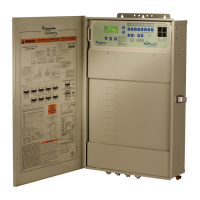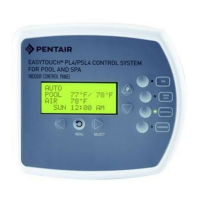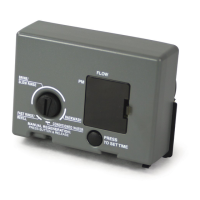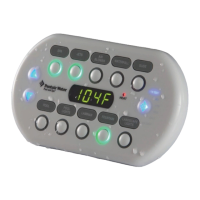39
EasyTouch Control System User’s Guide
SAT INDEX: The Saturation Index (SI), also called the Langelier Index, is a chemical equation or formula used to
diagnose the water balance in the pool. The Saturation Index formula is SI = pH + TF + CF + AF - 12.1. To calculate
the Saturation Index, you must first test the pool water for pH, temperature, calcium hardness, and total alkalinity.
Refer to a chart for assigned values for your hardness, and alkalinity readings then add these to your pH value.
Subtract 12.1, which is the constant value assigned to Total Dissolved Solids and a resultant number will be produced.
A result between -0.3 and +0.5 indicates balanced water. Test results not within these values require chemical
adjustments to achieve balance. This formula is more or less reliable but not guaranteed. In some cases, individual
readings for pH, calcium, and alkalinity might be beyond normal recommendations, however, combined within the
formula can produce “balanced water.” The SI is useful to pinpoint potential water balance problems.
pH: pH produced by IntelliChlor SCG is close to Neutral pH. However, other factors usually cause the pH of the
pool water to rise. Therefore, the pH in a pool chlorinated by IntelliChlor tends to stabilize at approximately 7.8.
This is within APSP standards. If the pool pH rises above 7.8, have a pool professional test to see if other factors
such as high Calcium Hardness or Total Alkalinity are the cause and then balance accordingly.
pH Level Test: Test the pH level of your pool water with a reliable test method. If necessary, adjust according
to your pool professional’s recommendations. APSP’s recommended ideal range for pH is 7.4 to 7.6. Note: Never
use dry acid (sodium bisulfate) to adjust pH in arid geographic areas with excessive evaporation and minimal
dilution of pool water with fresh water. A buildup of byproducts can damage the IntelliChlor SCG
Calcium Hardness: Recommended range for calcium hardness is 200-400 ppm. Calcium Hardness levels should be
tested weekly. Calcium hardness is the calcium carbonate scale deposited on pool surfaces. The test for Calcium
Hardness is a measure of how “hard” or “soft” the water is testing. “Hard” water can have high levels of calcium
and magnesium. If these levels are too high the water becomes saturated and will leave calcium carbonate scale
deposits (a “white-ish,” crystallized rough spot) on any surface inside the pool. If the levels are too low
, the water
becomes “soft” and will corrode surfaces inside the pool. Use TSP or Hydroquest 100 to lower Calcium Hardness
levels that are too high or add water to the pool which has a lower calcium hardness content. Levels which are too
low require the addition of calcium chloride.
Total Dissolved Solids (TDS): Adding salt to pool water will raise the TDS level. While this does not adversely
affect the pool water chemistry or clarity, the pool water professional testing for TDS must be made aware salt
has been added to the IntelliChlor system. The individual performing the TDS test may then subtract the salinity
level to arrive at a TDS level that would be compatible to a TDS reading for a non-salt water pool.
Total Alkalinity: APSP’s recommended ideal range for total alkalinity is 80 to 120 ppm for “gunite” and con-
crete pools and 125-170 ppm for painted, vinyl, and fiberglass pools. Test levels weekly and adjust according to
your pool professional’s recommendations. Alkalinity can be described as a buffer that keeps pH in order. pH
depends on the ability of the alkalinity in the water to withstand the changes in pH. If the alkalinity is too high,
adding acid (similar to pH) lowers the level. Adding a base (e.g sodium bicarbonate) when alkalinity is low, raises
the level. The level of alkalinity in the water is a measurement of all carbonates, bicarbonates, hydroxides, and
other alkaline substances found in the pool water.
Cyanuric Acid: Cyanuric acid is needed in outdoor pools to help to stabilize and maintain proper levels of
chlorine. 90% of unstabilized chlorine is destroyed by the UV radiation from the sun within two hours. Cyanuric
acid stabilizes chlorine in water from UV degradation. When using the IntelliChlor SCG, the cyanuric acid level
should be maintained between 50-80 ppm.

